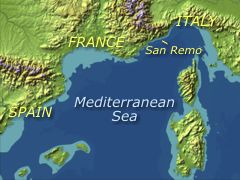
Named for the last Atlantic Fleet’s last Commander in Chief following World War I, who had died earlier that year, the “Jones” was the lone Benson-class destroyer built at Charleston Navy Yard. Sponsored at launch, 14 December 1939, by the admiral’s widow, Jones commissioned 6 September 1940 and, following shakedown, joined Destroyer Squadron 7.
Like other ships in the squadron, she operated first on Neutrality Patrol escort duty in the Caribbean and then in the North Atlantic for three more years. An early highlight of this service was her rescue of 11 survivors of flush-deck destroyer Reuben James en route to Iceland, 31 October 1941, when that ship became the first American warship torpedoed and sunk by a German U-boat. On 23–24 February 1943, the Jones and other ships of her Destroyer Division 14 (flagship Charles F. Hughes, Madison and Lansdale) and four British corvettes battled a wolfpack of 10 or more U-boats while escorting convoy UC-1, 33 ships bound from Britain to Curaçao. Late in the action, after three tankers had been lost, Jones drove off three last U-boats, after which the group’s British commander wrote “No escort group has ever been better supported.”
In January 1944, the Jones was transferred to the Mediterranean. She was not on hand with RAdm. F.J. Lowry’s Task Force 81 for the “Operation Shingle” landings at Anzio that month, but with her division, joined in February to cover landings and provide fire support.
Continuing operations in the Mediterranean, on 14–15 May she operated with Ellyson, Hambleton, Rodman, Emmons, Macomb, Gleaves, Nields and a British Wellington bomber in one of the most extended submarine hunts of the war, later called “Operation Monstrous,” which ended when the first three-mentioned sank U-616 off northeastern Spain.

San Remo, Italy.
In August, Hilary P. Jones departed Naples escorting French and British ships for “Operation Anvil,” the invasion of Southern France. There during the assault, she provided gunfire support and acted as an electronic jamming vessel in a successful attempt to prevent radio-controlled bombs from harassing the area.
In the following weeks, she continued supporting the First Airborne Task Force—bombarding bridges, gun emplacements, railroad facilities and coastal vessels. On 21 August, she destroyed an attacking E-boat with gunfire. From 5–10 September, with Madison and Ludlow, she battled human torpedoes. From 8–30 September, off San Remo and Porto Maurizio, Italy, she engaged in 38 fire support missions, including actions on 17–18 September—the last offensive destroyer action in the European theater—from which she emerged with the nickname “High Pressure Jones” and her Navy Unit Commendation.
Detached from coastal support duties in October, the Jones continued escorting convoys in the Mediterranean until returning to New York in January 1945. Following overhaul, she escorted one more transatlantic convoy before reassignment to the Pacific Fleet, departing New York 24 April.
Based at Pearl Harbor until June, she then joined surface patrol forces in the Caroline Islands, operating from Ulithi, where she was when Japan surrendered. Departing Ulithi 18 August escorting occupation troops, she entered Tokyo Bay 2 September as the surrender ceremony was under way. She subsequently escorted two more occupation troop convoys to Japan before returning to Charleston via Pearl Harbor and the Panama Canal.
Hilary P. Jones decommissioned 6 February 1947 and was placed in the Charleston Group, Atlantic Reserve Fleet until being loaned to the Republic of China under the Military Assistance Program 26 February 1954, where she served as Han Yang (DD-15).
In addition to her Navy Unit Commendation, Hilary P. Jones earned four service stars during World War II.
Sources: Roscoe, DANFS and shipmate Al Malcomson, USS Hilary P. Jones.